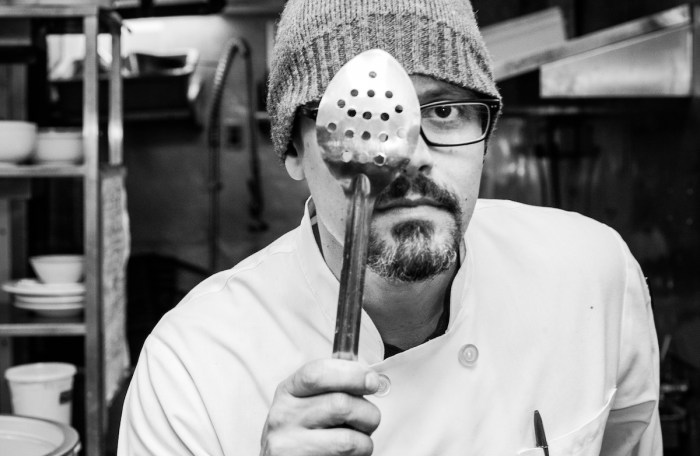“Chef” is pretty far down on Tom Colicchio’s list of job titles these days.
The grand poobah of Top Chef can be found advocating for legislation to label GMOs, speaking out about how to fight hunger in American communities and agricultural subsidy reform, just to name a few issues he’s taken to heart since becoming closely acquainted with a personal story of hunger. RELATED: Known for Aussie game, Public makes a vegetarian shift He was familiar with hunger issues from his work as a chef and fundraisers for Food Bank for New York City and God’s Love We Deliver, among many others. But six years ago his wife, Lori Silverbush, was mentoring a young girl whom they learned was going hungry at her private school, which didn’t serve breakfast or lunch. She ended up making a film,A Place at the Table, and Colicchio never got off the soapbox it provided. “We learned very quickly that the problems that we had in this country was not a lack of resources but bad policies, and therefore bad politics,” he says. To change the conversation about food in America — where48 million peopleare food insecure — he’s worked with organizations like theEnvironmental Working Groupand co-foundedFood Policy Actionto create a coalition of food-motivated voters and holding elected officials responsible for their votes on food-related issues with a scorecard. Just this week, the House Agriculture Committee met in Washington, D.C. to discuss how edible food ends up in landfills rather than hungry people’s plates. Colicchio was there, and he also took part in aroundtable at the White Houseon the issue. Between congressional hearings, he’s also bringing the issue of health into the place that’s most vital and at the same time neglected: home kitchens. Acknowledging recent research that shows exercise alone doesn’t improve health as much without a more nutritious diet, the life insurance companyJohn Hancockhas partnered with Colicchio to promote its newVitalityprogram, which refunds up to $600 a year to policyholders for making better food choices at grocery stores. Ask any chef about processed food, and you’ll get a sneer at best. But Colicchio sees the problem going even deeper. “Food has been so cheap for so long that we tend to throw a lot out, we’re very wasteful as a country,” he says. “We’re so far away from growing food ourselves and understanding the labor that goes into it that it doesn’t mean much. We throw out 40 percent of what we produce, a lot of it is left in the field, a lot of it gets wasted when it’s packaged because it’s not the right size or has a blemish on it. “And once it gets to the supermarket, it’s sitting out — if there’s one head of lettuce, you’ll never buy it, [the display] has to be full, so that leads to waste. And then we waste a lot at home. If it ends up in the garbage, it ends up in a landfill and creates methane. So along the whole supply chain there is waste.” RELATED: Dizengoff continues NYC’s education in Israeli cuisine Even with the right ingredients, what we value when it comes to food has its own issues. “Certainly we fetishize food, probably because of food TV, the role that chefs play in pop culture these days, without a doubt we’re all guilty of that,” Colicchio acknowledges. “I think the problem is it creates this performance anxiety when some cooks are cooking at home, when the average home cook sees there shows and all this complicated, fancy stuff.” But food like that is created with the help of a team of cooks, and served to well-paying customers. If you’re lucky enough to score an invite to Colicchio’s dinner table, expect a totally different experience. “When I’m at home, it’s a simple roast chicken, it’s a simple pasta dish, it’s vegetables that are, you know, asparagus cooked with some olive oil or peas, whatever is in season.” Whether it’s individual incentives to buy healthy food or the ultimate goal of changing how agricultural subsidy money is allocated — “we’ve gone from 1 percent to fruits and vegetables to about 4-6, so we’re making some progress” — Colicchio’s goal is making better food more affordable, and therefore accessible.“We’ve gotta start understanding that it’s something that’s precious.” Follow Eva Kis on Twitter @thisiskis


















